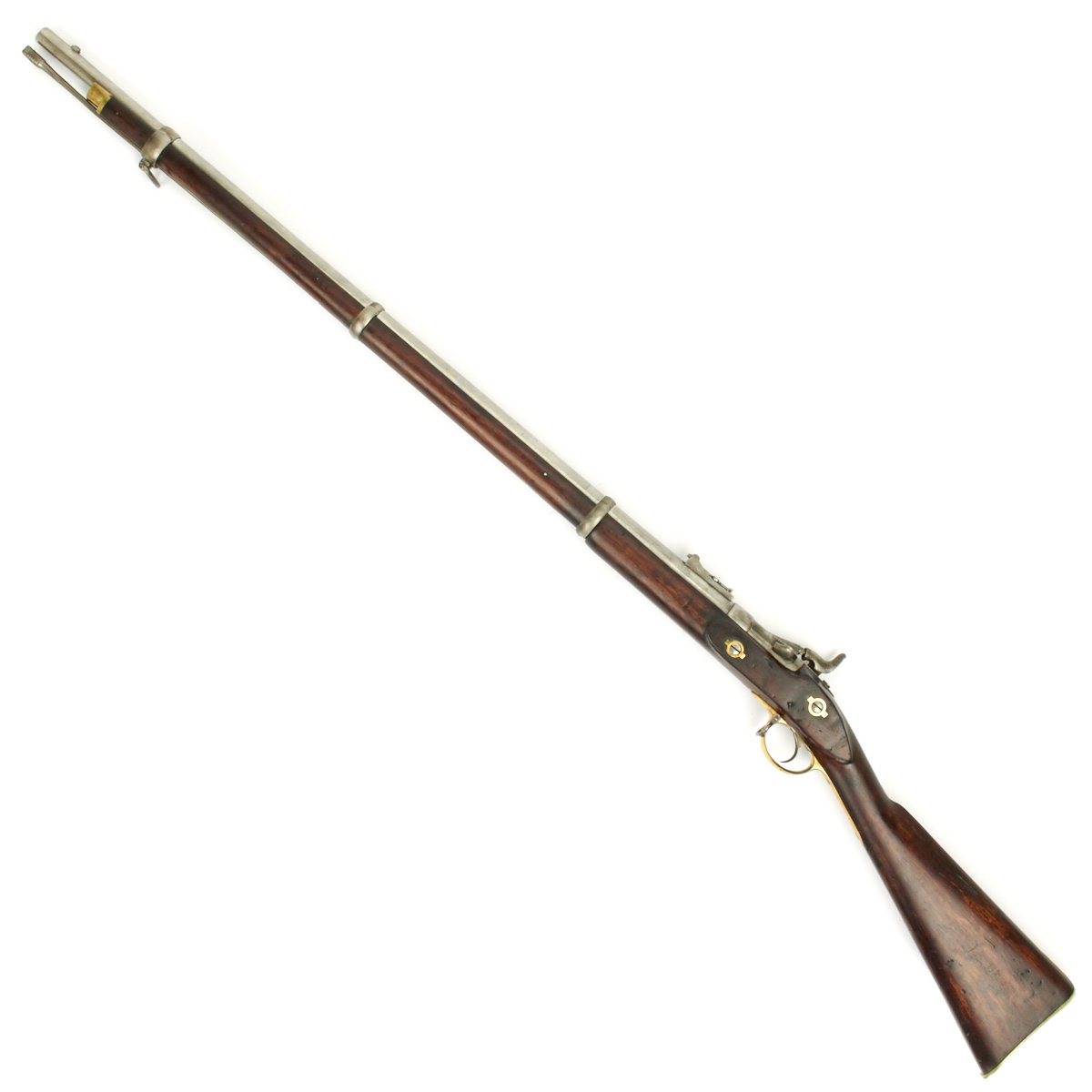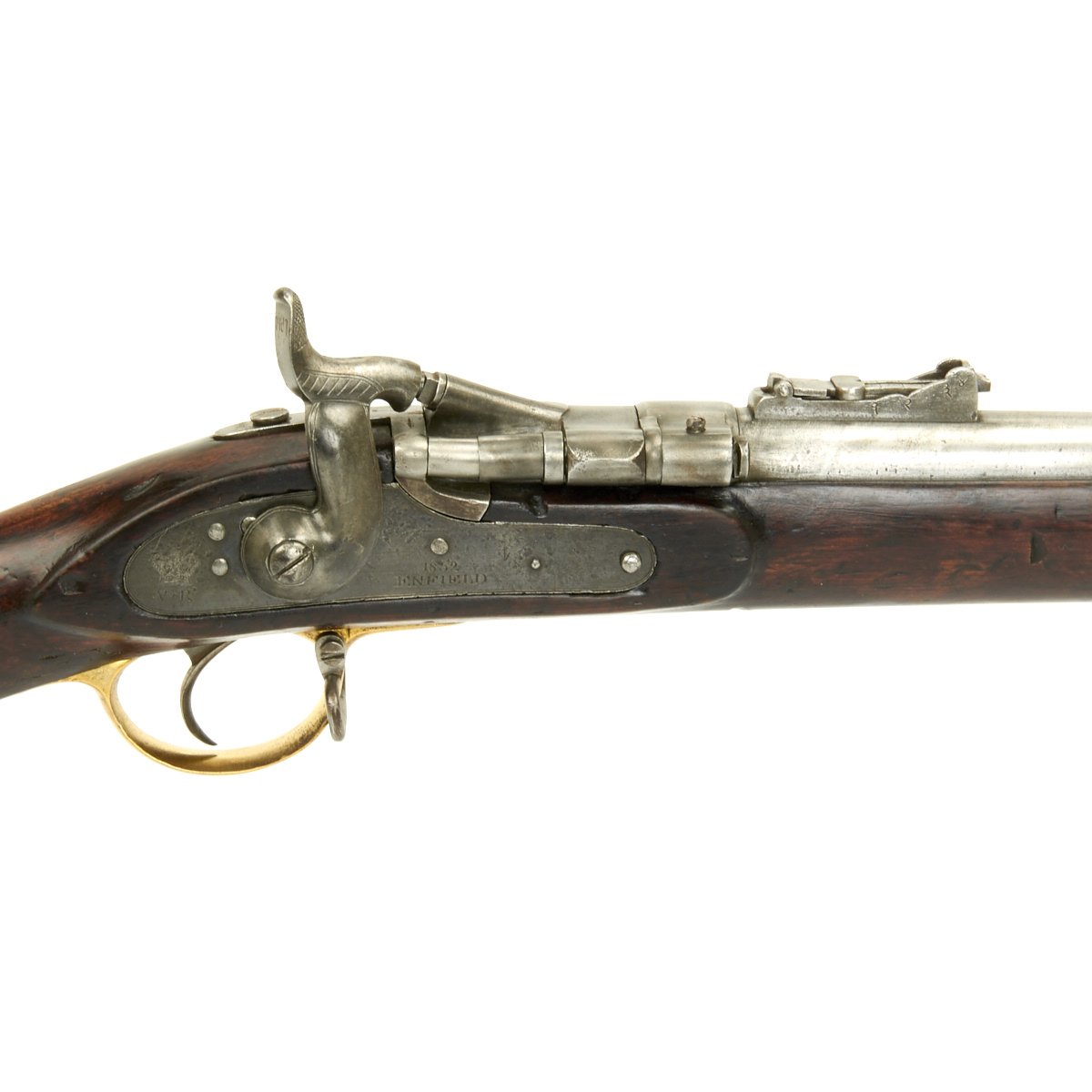Original British Enfield 1852 Five Groove Snider Breech Loading Rifle from Nepal Original Items
$ 1.095,00 $ 273,75
Original Item. Only One Available. Unlike the other unmarked Snider rifles we offer, IMA has found this one with an Enfield 1852 marked lock. While there is not a question that the lock plate or the entire lock was made in England it is our belief this weapon was assembled in the kingdom of Nepal in the latter 1870s and 1880s. The exceptional thing about this rifle is that the barrel, absent Brotosh proff marks, has FIVE GROOVE rifling that has crisp lands and grooves with a mirror bright shiny bore. This variation of Snider rifle from Nepal is exceptionally rare and very high quality.
At that time the Nepalese were very adept gun makers and would use whatever good gun parts were available, therefore on some of these Snider rifles it is not uncommon to find dates in the early 1850s and even the 1840s. Meaning that the locks were adapted from P-1840 muskets also known as East India Company Pattern Muskets. Other markings vary, if any are visible, most locks date in the 1850s. Here is a chance to own a very interesting part of history of which very few exist.
Offered in cleaned and complete condition, this is the best we have, and has been inspected to be in complete condition and 100% cleaned by our expert antique gunsmith.
History of the Snider rifle- Jacob Snider, an American from New York, developed this breech loading system for the P-1853 Enfield, the most prolific imported Percussion rifle in use by both the North and South during the U.S. Civil War. When the British Board of Ordnance appointed a Select Committee in 1864 the Snider system was swiftly adopted with the first breech loaders being issued in 1865 to British forces.
Improved in 1867 by the use of Colonel Boxer’s center fire brass bodied cartridge, the rifle was used very effectively in the Abyssinian Campaign of 1868. The system utilized a hinged breech block with an internal firing pin assembly that permitted the use of a self contained cartridge of lead bullet in cardboard, and, after 1867, brass casing. This highly efficient conversion system prolonged the active life of the P-1853 rifles up until 1871 when the Martini System was adopted. Snider rifles saw continued use throughout the Empire but were officially obsoleted by the late 1880s.
NOTE: International orders of antique firearms MUST be shipped using UPS WW Services (courier). USPS Priority Mail international will not accept these.
Fast Shipping with Professional Packaging
Thanks to our longstanding association with UPS FedEx DHL, and other major international carriers, we are able to provide a range of shipping options. Our warehouse staff is expertly trained and will wrap your products according to our exact and precise specifications. Prior to shipping, your goods will be thoroughly examined and securely secured. We ship to thousands clients each day across multiple countries. This shows how we're dedicated to be the largest retailer on the internet. Warehouses and distribution centres can be located throughout Europe as well as the USA.
Note: Orders with more than one item will be assigned a processing date depending on the item.
Before shipping before shipping, we'll conduct a thorough inspection of the items you have ordered. Today, the majority of orders will be delivered within 48 hours. The delivery time will be between 3-7 days.
Returns
The stock is dynamic and we cannot completely manage it because multiple stakeholders are involved, including our factory and warehouse. So the actual stock may alter at any time. It's possible that you may not receive your order once the order has been made.
Our policy is valid for a period of 30 days. If you don't receive the product within 30 days, we are not able to issue a refund or an exchange.
You can only return an item if it is unused and in the same state as the day you received it. You must have the item in its original packaging.
Related products
Uncategorized
Armoured Fighting Vehicles of the World: AFVs of World War One (Hardcover Book) New Made Items
Uncategorized
Uncategorized
Uncategorized
Uncategorized
Uncategorized
Uncategorized
Band of Brothers ORIGINAL GERMAN WWII Le. F.H. 18 10.5cm ARTILLERY PIECE Original Items
Uncategorized
Uncategorized
Armored Burgonet Helmet & Polearm from Scottish Castle Leith Hall Circa 1700 Original Items
Uncategorized
Uncategorized
Uncategorized
Uncategorized
Uncategorized
Uncategorized
Uncategorized
Uncategorized












































































